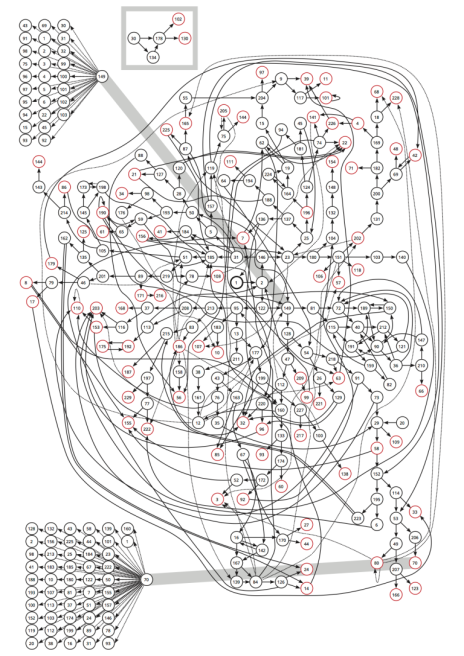The Great Untranslated: Neuromaani by Jaakko Yli-Juonikas
 The problems with Yili-Juonikas’ experimental 650-page novel Neuromaani start already with the title. According to translator Doug Robinson, who mentions this book in an interview for The Collidescope, the ambiguous title can be translated as Neuronovel, Neuromaniac, or My Neurocountry.
Once you get past that, it gets only worse. There are at least three
degrees of inaccessibility you have to reckon with when it comes to Neuromaani.
Firstly, and most obviously, if you, like myself, don’t know Finnish,
you cannot hope to read the novel even in theory, and all you are left
with is the impressions of other people shared in a language you
understand. The second degree is applicable to you if you know the
language but have just learnt about the existence of Neuromaani.
You still won’t be able to read the novel because it is out of print
and is impossible to get in any online used bookstores. The third degree
of inaccessibility is for the lucky ones: you are not only proficient
in Finnish but also managed to buy your copy when it was still
available. But even you can’t possibly read the book in its entirety. Of
course, you can try and read all the pages from first to last, but
instead of following the story, you will be exposed to a jumble of
incoherent episodes without rhyme or rhythm. Such a stab at the
old-fashioned linear method of reading will leave you frustrated and
suffering from a headache. All you can hope for is to experience some
parts of Neuromaani by undertaking a series of non-linear journeys through the novel, making choices at the end of each chapter.
The problems with Yili-Juonikas’ experimental 650-page novel Neuromaani start already with the title. According to translator Doug Robinson, who mentions this book in an interview for The Collidescope, the ambiguous title can be translated as Neuronovel, Neuromaniac, or My Neurocountry.
Once you get past that, it gets only worse. There are at least three
degrees of inaccessibility you have to reckon with when it comes to Neuromaani.
Firstly, and most obviously, if you, like myself, don’t know Finnish,
you cannot hope to read the novel even in theory, and all you are left
with is the impressions of other people shared in a language you
understand. The second degree is applicable to you if you know the
language but have just learnt about the existence of Neuromaani.
You still won’t be able to read the novel because it is out of print
and is impossible to get in any online used bookstores. The third degree
of inaccessibility is for the lucky ones: you are not only proficient
in Finnish but also managed to buy your copy when it was still
available. But even you can’t possibly read the book in its entirety. Of
course, you can try and read all the pages from first to last, but
instead of following the story, you will be exposed to a jumble of
incoherent episodes without rhyme or rhythm. Such a stab at the
old-fashioned linear method of reading will leave you frustrated and
suffering from a headache. All you can hope for is to experience some
parts of Neuromaani by undertaking a series of non-linear journeys through the novel, making choices at the end of each chapter.
Neuromaani mimics the choose-your-own-adventure book, but it’s more than that. The choices themselves are not only practical (e.g. stay in bed or get up) but also emotional, ethical, and even metaphysical. It doesn’t take the reader long to reach a dead-end triggered by many unexpected outcomes, from hilarious to gruesome, and be compelled to retrace the steps and try again, with a different set of choices. If that weren’t enough, in some cases there are no choices at all: do as you please. There are also copious footnotes and references to both real and fictitious sources. Ultimately, reading Neuromaani is more like stumbling in the garden of forking paths sprouting in the mind of Silvo Näre, a criminal placed in a psychiatric clinic, to follow the misadventures of a weird fellow called Gereg Bryggman, his auditory hallucination personified.
Just to give you the idea of how complex Neuromaani is, I’d like to remind you first of the table of instructions provided by Julio Cortázar for the second method of reading his ergodic classic Hopscotch:
To read the second version of the novel dispersed throughout the pages of Cortázar’s book, you have no choice but jump all over the place, following this chart, which seemed pretty convoluted at the time Hopscotch was published. Now compare this “map” to the one made by the author of the blog Enneuni (Premonition) to reflect all the possible ways of reading Neuromaani:

Map of Neuromaani, Version 1.0. Image Source
Meandering inside the brain of a criminally insane patient from Turku is nothing like hopping between the adventures of Argentine bohemians in Paris and the unorthodox theories of an obscure avant-garde writer.
Encyclopedic in its form and content, Yili-Juonikas’ novel is never dry: it proffers to the reader facts and data from different areas of knowledge in a playful manner. It juggles a variety of genres and styles as well as depicts invented characters and situations alongside real-life personages and well-documented events. It is an academic research paper, a true crime investigation and an exciting thriller in which the possibilities of things ending bad keep branching out after each choice made by the reader. One cannot think of a better paean to the awe-inspiring complexity of the human brain than the awe-inspiring complexity of Neuromaani.
